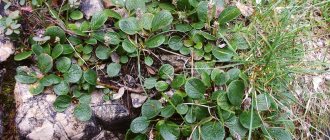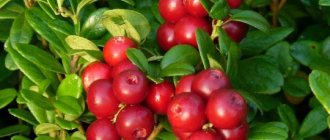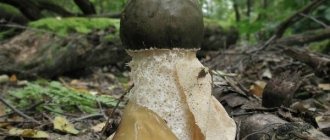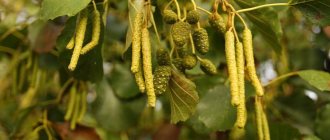Cranberry (Oxycoccus) is a subgenus of flowering plants belonging to the heather family. It is represented by evergreen creeping shrubs, found in the wild in the Northern Hemisphere. The berries of any type of cranberry are edible, and they are widely used in the food industry and in cooking. The scientific name of this plant translated from ancient Greek means “sour berry”. American pioneers called this shrub “craneberry.” And in the 17th century in New England, this plant was called “bearberry”, due to the fact that people more than once saw grizzly bears eating it. How the Russian name for cranberry came about has not been precisely established at the moment, but in some dialects it is called “crane” by analogy with the word cranberry, which came from America.
Under natural conditions, this shrub prefers to grow in damp places, for example: in swamps, in coniferous sphagnum forests, along the swampy banks of various reservoirs. Gardeners cultivate only 1 species - garden cranberry.
Features of cranberries
Cranberry is a creeping shrub. The height of evergreen bushes can vary from 0.15 to 0.6 m. Tap root system. The oblong or ovoid leaf plates are alternately arranged and have short petioles. Their length is 1.5 cm and width is 0.6 cm. The front surface of the leaves has a dark green color, and the back surface is covered with a waxy coating, which is why it has a whitish color. The wax coating provides protection to the leaf plates from water. The shrub blooms in May or June. The color of the flowers is pale purple or pink, they are located on long stalks. The lifespan of one flower is 18 days. The fruit is a red sour berry, spherical or ovoid, reaching 1.6 cm in diameter. Cranberry fruits have medicinal properties, making them very popular. However, in gardens it can be found much less often than raspberries, red and black currants, gooseberries or strawberries. But in recent years it has become increasingly popular among gardeners, as are blackberries, blueberries, strawberries and blueberries.
Cranberries in the garden.
Cooking cranberries at home
Making cranberry preparations for the winter will help you have an excellent cold remedy on hand. Drinking various cranberry drinks strengthens the immune system and improves overall health.
Cranberry juice can be consumed freshly squeezed. You need to mash the berries and heat them a little to separate the liquid. The resulting pulp is squeezed out and filtered.
Cranberry juice is a refreshing vitamin drink that you can easily prepare at home. You need to take 600 g of cranberries, 200 g of sugar and 300 ml of water. All ingredients should be mixed and taken freshly prepared.
An excellent addition to meat dishes is cranberry sauce. You need to bring 500 g of fresh berries, 2 apples, cut into pieces, 150 g of powdered sugar and a cinnamon stick to a boil with a small amount of water. The sauce is simmered over low heat until the berries begin to burst, the apple pieces become soft, and the composition thickens. Remove the finished sauce from the heat, cool and serve with the main dish, removing the cinnamon stick.
Planting cranberries in open ground
What time to plant
It is recommended to plant cranberries in open ground at the beginning of spring, immediately after the soil in the area has thawed to a depth of 8 to 10 centimeters. An open, well-lit area with a high degree of humidity is suitable for planting such a shrub. It is better to choose a place where the soil will lie very close to the surface of the soil. If there is a stream, pond or small lake on the garden plot, then it is recommended to plant the shrub on the shore of such a reservoir; in this case, it can be grown even in slight shade from nearby trees. This plant needs acidic peat soil with a pH of 3.5–4.5, or you can use a forest substrate with sphagnum. If the soil on the site differs significantly from the required one, it is necessary to remove the top layer of earth, the thickness of which should be from 20 to 25 centimeters, and in its place a more suitable soil mixture should be poured, consisting of sand, peat, forest humus and forest soil , which must be taken in the proportion 1:2:1:1. You also need to add rotted pine needles to this mixture.
Planting cranberries in spring
Immediately before planting, you need to make holes in the soil, the depth of which will be 10 centimeters, the distance between them should be about 20 centimeters. The finished wells should be shed with lukewarm water. 2 seedlings are placed in one hole at once, and their height should be from 15 to 20 centimeters. Then the hole needs to be filled with soil; there is no need to compact it. On planted cranberries, the first fruits will grow only in the third year, and it will begin to bear full fruit only in the fourth year. On average, 500 grams of fruit are harvested from one square meter. During the first two years, this shrub will simply be a spectacular decoration of the garden plot. Designers often decorate the landscape with very beautiful cranberry bushes.
How to plant cranberries
Planting cranberries in autumn
Cranberries are not planted in autumn. However, in September it is recommended to start preparing the place for planting cranberries in the spring. The area for planting cranberries should first of all be fenced off; to do this, it is necessary to dig into the soil around its perimeter to a depth of twenty centimeters some material that does not rot, for example: plastic, slate or pieces of roofing felt. This fence should protrude 0.2–0.3 m above the soil surface.
When are cranberries harvested and how is it done?
The flowering period for cranberries is late spring and early summer. But it begins to bear fruit only in September and ends by November. During this period, people collect it. By the way, this berry is not afraid of frost, so you don’t have to worry that it will disappear if frost suddenly hits.
People have been “hunting” cranberries for a long time, and in those regions where the berry is traditional, they have already gotten the hang of doing it. But it will be quite difficult for a beginner or a guest to collect it, because cranberries do not grow near human settlements, and besides, they are capable of luring them into a quagmire, covering the swamp with a net of branches and thereby not allowing them to be seen in time. When harvesting cranberries, extreme caution is used.
There is one more trick for the “cunning” berry. She skillfully hides her fruits under the branches from human eyes; finding them is not easy. Experienced gatherers use a special wooden or bone comb, with which they lift the branches and remove the fruits from them.
Cranberry care
Caring for cranberries in spring
Growing cranberries is very easy, even for a novice gardener. In early spring, when the berry bush begins to turn green, this shrub will need thinning pruning, as well as fertilizing with full mineral fertilizer. Remember that you should feed the plant with a not very concentrated mixture. The fact is that it is better to underfeed cranberries than to overfeed them. Make sure that the soil is always slightly moist, regularly loosen the surface of the area, and at the same time pull out the weeds. To pollinate cranberries, bees are needed, therefore, next to this shrub, you need to plant any honey plants, for example, oregano, savory, etc.
Caring for cranberries in summer
In the summer, especially from mid-July to the end of August, you need to make sure that the soil in the garden bed is always a little damp. As mentioned above, in order for cranberries to grow well, they need acidic soil, so to water a plant that is already 3 or 4 years old, you should use water mixed with citric acid or vinegar. If the growth of the bush deteriorates, it needs to be fed by pouring fertilizer into the water. Carry out preventive treatments with fungicides. Diseased cranberry bushes are sprayed with the same preparations. Periodically loosen the soil surface and pull out weeds. During the first three years, this shrub must be weeded systematically. The surface of the soil around bushes that are more than three years old must be covered with a layer of mulch (coarse sand or peat chips) once every 3 or 4 years, and its thickness should be 15–20 mm.
Caring for cranberries in autumn
In autumn, it's time to harvest. The berries are picked when they are not ripe, and this time occurs in September or October. Fruit ripening occurs already during storage.
What care will the shrub need when the harvest is over? In order to protect plants from pests and diseases, from light winters and frosts in the spring, when the outside temperature drops to minus 5 degrees, the cranberries must be filled with a two-centimeter layer of water. Wait until this layer freezes completely and pour another similar layer of water. This procedure must be repeated until the bushes are completely covered in ice. If the winters in your region are relatively mild, this shrub will only need shelter (spunbond or spruce branches).
Cranberry processing
In order for cranberries to grow normally, the soil must be moist all the time, and in such an environment there is a high probability of developing a fungal disease. In this regard, cranberries require periodic preventive spraying with fungicidal preparations, which are carried out several times a season. In spring, when the buds begin to swell and open, the bush is treated with Azophos or Bordeaux mixture (1%). During the formation of buds, this plant will need 3 sprayings with a break of 7 days; for this, use a solution of Horus or Skor (take 4 grams of any of these preparations for 1 bucket of water). This treatment will protect the cranberries from spotting and gray mold. If this is necessary, then when the bush fades, it is sprayed again to remove gray mold. In November, the area is sprayed with Bordeaux mixture (1%).
How to water
Freshly planted seedlings will need daily watering for the first six months. Next, you need to make sure that the soil is always a little damp, but not soggy. From June to May, the shrub should be watered not very often and moderately, because excess liquid during this period has an extremely negative effect on the quality of the crop. On hot days, the plant needs cooling watering. During prolonged drought, cranberries need to be watered every day. In August–October, plants must be watered systematically. Cranberries need to be watered so that the soil is moistened to the depth of the root layer.
Fertilizing cranberries
In order for such shrubs to grow and develop normally, they need to be systematically fed. The first feeding of freshly planted seedlings is carried out 20 days after planting. To do this, use the Universal complex fertilizer, so for 1 square meter of land, take ½ part of a large spoon of this nutrient mixture. You will need to feed cranberries in this way once every half month until the end of July. The next feeding is carried out in mid-August, and then in mid-October, for this they use Autumn fertilizer (1/3 of a large spoon per 1 square meter). In the second and third years, cranberries should be fed in the same way. During the fourth and all subsequent years, a reduction in the amount of fertilizer will be needed, so during the growing season the cranberries will need to be fed 6 times, taking 1/3 of a large spoonful of fertilizer for every 1 square meter.
Cranberries in your garden
Description of cranberries
Cranberry
Cranberry is Latin for Oxycoccus and is an evergreen shrub that belongs to the group of flowering plants in the Ericaceae family. Its closest relatives are the familiar lingonberries, blueberries, blueberries, as well as the mysterious Erica, Kalmia, Podbel and others.
If we are to be completely accurate and follow the botanical canons, then we should mention some differences in the opinions of scientists regarding cranberries. Some of them believe that Oxycoccus is an independent genus, others believe that this plant is a subgenus of the genus Vaccinium (which includes all the berries listed above). And there is also this version: cranberry is a section of the specified genus, that is, a rank located between genus and species.
Be that as it may, you, like me, are probably no less interested in knowing what this plant looks like, how to grow it at home, what to cook from its fruits, and what benefits all this will bring to our body.











